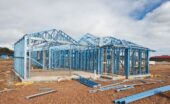The Role of Measurement in Designing Sustainable Homes
Written by SayBuild-admin // September 26, 2024 // Home Construction // Comments Off on The Role of Measurement in Designing Sustainable Homes

Designing a sustainable home involves more than just choosing eco-friendly materials and cutting-edge technology. It also depends on precise measurement, which ensures that every choice contributes toward the home’s sustainability goals. Let’s explore how measurement plays a pivotal role in designing homes that are not only environmentally friendly but also efficient and practical.
Energy Efficiency
Energy efficiency forms the backbone of a sustainable home. Precise measurement of energy consumption helps homeowners make informed decisions about appliances, insulation, and lighting.
For example, determining the home’s orientation and natural light levels can guide the design of windows or skylights, both of which reduce reliance on artificial lighting. Meanwhile, energy-efficient appliances are selected based on their energy ratings, ensuring that each device contributes to lower consumption and reduced carbon footprint.
Material Selection and Waste Reduction
A sustainable home design doesn’t mean much without the right materials to build it. Measurement here is vital in two aspects—selecting the appropriate materials and ensuring minimal waste. Promoting sustainability with precise building measurement services helps you manage your resources appropriately.
In addition, measuring the thermal properties of various materials allows you to choose those that offer better insulation, effectively reducing heating and cooling demands. This attention to detail helps contractors build and remodel homes that are not only sustainable but also cost-effective.
Water Conservation Techniques
For a home to be truly sustainable, it needs to conserve water as much as possible. Precise measurement of water usage aids in the selection of fixtures and appliances that minimize consumption.
Low-flow toilets, showerheads, and faucets, when chosen based on measured water efficiency, can greatly reduce your household’s water usage. Additionally, rainwater harvesting systems benefit from careful measurement of roof surface area and precipitation levels, which helps you design a system that maximizes collection and storage potential.
Indoor Air Quality Measurements
The quality of a home’s indoor air directly affects the health and well-being of its occupants. The measurement of air quality parameters, such as humidity and pollutant levels, guides the integration of ventilation systems that maintain a healthy indoor environment.
Furthermore, air quality sensors provide data in real time, allowing you to adjust your ventilation strategies according to current needs, maintaining optimal living conditions.
Renewable Energy Systems
A sustainable home often incorporates renewable energy systems like solar panels or wind turbines. Precise measurements can determine the feasibility and efficiency of these systems.
Calculating the solar exposure or average wind speed at a site helps in selecting the appropriate type and size of energy systems. This approach ensures that the renewable energy systems installed provide maximum benefits, reducing the home’s reliance on traditional energy sources.
Measurement, with its ability to provide precise data, empowers sustainable home design by informing every decision, from energy efficiency to material selection. By embracing these measurements, designers and homeowners alike can create spaces that reflect a commitment to sustainability without compromising on comfort or functionality. In the end, it’s the meticulous attention to detail that transforms a mere structure into a truly sustainable home.
Image credentials: By Alberto Masnovo, File #: 175320806








 If you want to contribute tutorials, news or other money-related stuff:
If you want to contribute tutorials, news or other money-related stuff:  Share our home building library with your facebook friends:
Share our home building library with your facebook friends:  Do you have any ideas or suggestions you would like to make?
Do you have any ideas or suggestions you would like to make?  If you like what we do, please subscribe to our
If you like what we do, please subscribe to our  All content Copyright © 2012 SayBuild. Part of nBuy Home Management Network.
All content Copyright © 2012 SayBuild. Part of nBuy Home Management Network.